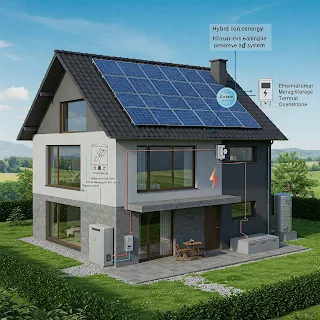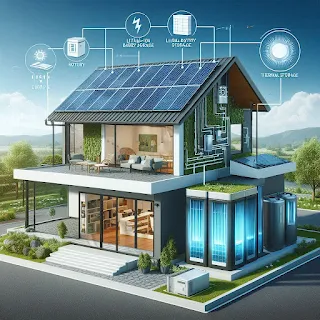As renewable energy continues to gain momentum, a major challenge remains: how to store and manage the power generated from sources like the sun. A recent innovation from researchers at the Technical University of Madrid offers a promising solution. By combining lithium-ion batteries with power-to-heat-to-power systems (PHPS), this hybrid approach may reshape how solar energy is stored, managed, and consumed.
This article explores the science behind this hybrid system, its potential impact, and the broader implications for global energy sustainability.
1. The Storage Challenge in Solar Power
1.1. Intermittency of Solar Energy
Solar energy is clean and abundant but not constant. Cloud cover, seasonal variation, and nightfall interrupt the supply.
1.2. The Limitations of Current Battery Technology
Lithium-ion batteries are widely used but come with issues:
Limited lifespan and degradation over time
High costs
Resource-intensive manufacturing
2. What is a Hybrid Energy Storage System?
2.1. Combining Battery and Thermal Storage The new hybrid system integrates:
Photovoltaic Panels to capture solar energy
Lithium-ion Batteries for short-term, fast-discharge storage
Thermal Batteries (PHPS) to convert excess energy into heat and store it
Heat Pumps to convert the stored heat back to electricity
2.2. Power-to-Heat-to-Power (PHPS) Concept
PHPS stores energy as heat in an insulated tank. When electricity is needed, a heat engine or pump reconverts the thermal energy back into usable power.
3. Advantages of the Hybrid System
3.1. Greater Efficiency and Stability
The hybrid approach balances the fast response of batteries with the long-term storage of thermal systems.
3.2. Cost-Effective Over Time
Thermal storage is cheaper to scale than lithium-ion systems, especially for large energy loads.
3.3. Sustainability and Resource Optimization
Reduces dependence on rare minerals used in battery production
Improves lifecycle emissions by utilizing heat capture
4. Real-World Application and Case Studies
4.1. Pilot Project in Madrid
The Technical University of Madrid is testing the system in a prototype smart home. Preliminary results show:
30% more efficient energy utilization
40% reduction in electricity bills
50% longer battery life due to reduced load
4.2. Future Prospects for Urban and Rural Areas
In urban homes: reduces grid dependency
In rural or off-grid regions: provides a reliable and cost-effective standalone system
5. Environmental and Policy Implications
5.1. Aligning with Net-Zero Goals
This system could help countries meet net-zero emissions targets faster by improving renewable storage.
5.2. Boosting the Circular Economy
Thermal systems often use recyclable or abundant materials, complementing circular economy initiatives.
5.3. Policy Incentives and Investment Opportunities
Governments and companies may fund hybrid storage projects under green energy and climate initiatives.
6. Scientific and Technical Challenges
6.1. Heat-to-Power Conversion Efficiency
Current conversion rates remain a bottleneck. Research is ongoing to improve efficiency beyond 40–50%.
6.2. Material Innovation and Cost Barriers
Innovative materials for heat insulation and high-temperature storage can improve feasibility.
6.3. Integration with Existing Infrastructure
Retrofitting buildings and integrating with smart grids requires new standards and technical training.
7. Future Outlook and Conclusions
7.1. The Road to Commercialization
Scaling the hybrid system beyond pilot projects will require partnerships between:
Universities
Tech companies
Government agencies
7.2. Empowering Energy Independence
This innovation can empower communities and businesses to achieve energy autonomy with minimal environmental impact.
7.3. A Greener Tomorrow
Combining battery and thermal storage marks a significant leap toward a sustainable energy future. With further research and policy support, hybrid systems may soon become the new standard in solar energy solutions.
Final Thoughts
The fusion of lithium-ion and thermal storage is not just a technical marvel—it represents a shift in how we think about and interact with energy. If successful on a large scale, this innovation could redefine the grid, lower energy costs, and help safeguard the planet for future generations.


No comments:
Post a Comment